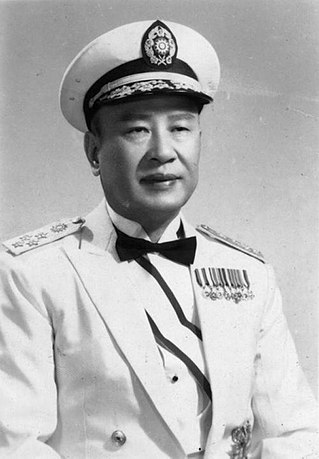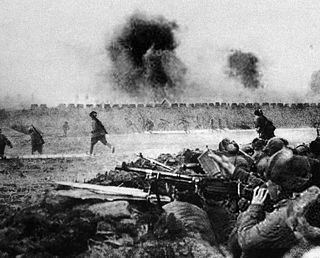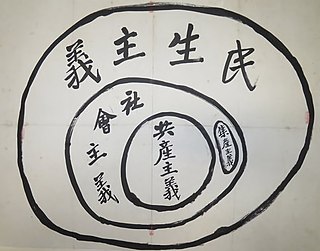Related Research Articles

Chiang Kai-shek was a Chinese politician, revolutionary, and military leader. He was the head of the Nationalist Kuomintang (KMT) party, General of the National Revolutionary Army, known as Generalissimo, and the leader of the Republic of China (ROC) in mainland China from 1928 until 1949. After being defeated in the Chinese Civil War by the Chinese Communist Party (CCP) in 1949, he led the ROC on the island of Taiwan until his death in 1975.

The Kuomintang (KMT), also referred to as the Guomindang (GMD), the Nationalist Party of China (NPC) or the Chinese Nationalist Party (CNP), is a major political party in the Republic of China, initially based on the Chinese mainland and then in Taiwan since 1949. The KMT is a centre-right to right-wing party and the largest in the Pan-Blue Coalition. Its primary rival is the Democratic Progressive Party (DPP) and its allies in the Pan-Green Coalition. As of 2024, the KMT is the largest single party in the Legislative Yuan. The current chairman is Eric Chu.

Soong Mei-ling, also known as Madame Chiang Kai-shek or Madame Chiang, was a Chinese political figure who was First Lady of the Republic of China, the wife of President Chiang Kai-shek of the Republic of China. Soong played a prominent role in the politics of the Republic of China and was the sister-in-law of Sun Yat-sen, the founder and the leader of the Republic of China. She was active in the civic life of her country and held many honorary and active positions, including chairwoman of Fu Jen Catholic University. During World War II, she rallied against the Japanese; and in 1943 conducted an eight-month speaking tour of the United States to gain support.

The Chinese Civil War was fought between the Kuomintang-led government of the Republic of China and the forces of the Chinese Communist Party (CCP), with armed conflict continuing intermittently from 1 August 1927 until 7 December 1949, resulting in a CCP victory and control of mainland China in the Chinese Communist Revolution.

Chiang Ching-kuo was a politician of the Republic of China. The eldest and only biological son of Generalissimo Chiang Kai-shek, he held numerous posts in the government of the Republic of China and ended martial law in 1987. He served as the 3rd premier of the Republic of China between 1972 and 1978 and was president of the Republic of China from 1978 until his death in 1988.

The Xi'an Incident was a major Chinese political crisis from 12 to 26 December 1936. Chiang Kai-shek, leader of the Nationalist government of China, was placed under house arrest in the city of Xi'an by a Nationalist army he was there to review. Chiang's captors hoped to end the Chinese Civil War and confront Japanese imperial expansion into Chinese territory. After two weeks of intense negotiations between Chiang, his captors, and representatives of the Chinese Communist Party (CCP), Chiang was released with a verbal promise to end the civil war and put up a firmer resistance to Japan.

The Northern Expedition was a military campaign launched by the National Revolutionary Army (NRA) of the Kuomintang (KMT) against the Beiyang government and other regional warlords in 1926. The purpose of the campaign was to reunify China, which had become fragmented in the aftermath of the Revolution of 1911. The expedition was led by Generalissimo Chiang Kai-shek, and was divided into two phases. The first phase ended in a 1927 political split between two factions of the KMT: the right-leaning Nanjing faction, led by Chiang, and the left-leaning faction in Wuhan, led by Wang Jingwei. The split was partially motivated by Chiang's Shanghai Massacre of Communists within the KMT, which marked the end of the First United Front. In an effort to mend this schism, Chiang Kai-shek stepped down as the commander of the NRA in August 1927, and went into exile in Japan.

Bai Chongxi was a Chinese general in the National Revolutionary Army of the Republic of China (ROC) and a prominent Chinese Nationalist leader. He was of Hui ethnicity and of the Muslim faith. From the mid-1920s to 1949, Bai and his close ally Li Zongren ruled Guangxi province as regional warlords with their own troops and considerable political autonomy. His relationship with Chiang Kai-shek was at various times antagonistic and cooperative. He and Li Zongren supported the anti-Chiang warlord alliance in the Central Plains War in 1930, then supported Chiang in the Second Sino-Japanese War and the Chinese Civil War. Bai was the first defense minister of the Republic of China from 1946 to 1948. After losing to the Communists in 1949, he fled to Taiwan, where he died in 1966.
The Green Gang was a Chinese secret society and criminal organization, which was prominent in criminal, social and political activity in Shanghai during the early to mid 20th century.

The Liaoshen campaign, an abbreviation of Liaoning–Shenyang campaign after the province of Liaoning and its Yuan directly administered capital city Shenyang, was the first of the three major military campaigns launched by the Communist People's Liberation Army (PLA) against the Kuomintang Nationalist government during the late stage of the Chinese Civil War. This engagement is also known to the Kuomintang as the Liaohsi campaign, and took place between September and November 1948, lasting a total of 52 days. The campaign ended after the Nationalist forces suffered sweeping defeats across Manchuria, losing the major cities of Jinzhou, Changchun, and eventually Shenyang in the process, leading to the capture of the whole of Manchuria by the Communist forces. The victory of the campaign resulted in the Communists achieving a strategic numerical advantage over the Nationalists for the first time in its history.

The Second United Front was the alliance between the ruling Kuomintang (KMT) and the Chinese Communist Party (CCP) to resist the Japanese invasion of China during the Second Sino-Japanese War, which suspended the Chinese Civil War from 1937 to 1945.

The Kuomintang (KMT) is a Chinese political party that ruled mainland China from 1927 to 1949 prior to its relocation to Taiwan as a result of the Chinese Civil War. The name of the party translates as "China's National People's Party" and was historically referred to as the Chinese Nationalists. The Party was initially founded on 23 August 1912, by Sun Yat-sen but dissolved in November 1913. It reformed on October 10, 1919, again led by Sun Yat-sen, and became the ruling party in China. After Sun's death, the party was dominated from 1927 to 1975 by Chiang Kai-shek. After the KMT lost the civil war with the Chinese Communist Party in 1949, the party retreated to Taiwan and remains a major political party of the Republic of China based in Taiwan.

The historical Kuomintang socialist ideology is a form of socialist thought developed in mainland China during the early Republic of China. The Tongmenghui revolutionary organization led by Sun Yat-sen was the first to promote socialism in China.
The Battle of Kalgan took place during the off and on mediation of a cease fire between the Kuomintang and the Chinese Communist Party by George Marshall. It was fought in the renamed city of Zhangjiakou, China.
The Second Battle of Ürümqi was a conflict in the winter of 1933–1934 at Ürümqi, between the provincial forces of Sheng Shicai and the alliance of the Chinese Muslim Gen. Ma Zhongying and Han Chinese Gen. Zhang Peiyuan. Zhang seized the road between Tacheng and the capital. Sheng Shicai commanded Manchurian troops and a unit of White Russian soldiers, led by Col. Pappengut. The Kuomintang Republic of China government had secretly incited Zhang and Ma to overthrow Sheng—even as they prepared to swear him in as governor of Xinjiang—because of his ties to the Soviet Union. Chinese Nationalist leader Gen. Chiang Kai-shek sent Luo Wen'gan to Xinjiang, where he met with Ma Zhongying and Zhang Peiyuan and urged them to destroy Sheng.
The concept of martyrdom in China during the premodern period largely concerned loyalty to political principles and was developed in modern times by revolutionaries, such as the Tongmenghui and the Kuomintang parties during the Xinhai Revolution, Northern Expedition, and Second Sino-Japanese War.

The Shilin Official Residence is the former residence of late Republic of China President Chiang Kai-shek located on Zhongshan North Road in Shilin District, Taipei, Taiwan.
Events in the year 1928 in China.
Jay Taylor was a former U.S. foreign service officer, academic, documentarian, and writer. He was best known for writing The Generalissimo, a biography of Chiang Kai-Shek which won the Lionel Gelber Prize for the best English non-fiction book on Foreign Policy in 2010.

Chiangism, also known as the Political Philosophy of Chiang Kai-shek, or Chiang Kai-shek Thought, is the political philosophy of President Generalissimo Chiang Kai-shek, who used it during his rule in China under the Kuomintang on both the mainland and Taiwan. It is a right-wing authoritarian nationalist political ideology which is based on mostly Confucian and Tridemist ideologies, and was used in the New Life Movement in China and the Chinese Cultural Renaissance movement in Taiwan. It is a syncretic mix of many political ideologies, including revolutionary nationalism, Tridemism, socialism, militarism, Confucianism, state capitalism, constitutionalism, fascism, authoritarian capitalism, and paternalistic conservatism, as well as Chiang's Methodist Christian beliefs.
References
Taylor, Jay (2009), The Generalissimo: Chiang Kai-shek and the Struggle for Modern China, The Belknap Press of Harvard University Press